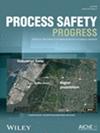Dispersion evaluation of hydrogen sulfide inclusion in a cryogenic distillation pilot plant
IF 1
4区 工程技术
Q4 ENGINEERING, CHEMICAL
引用次数: 0
Abstract
A risk analysis simulation was completed for a cryogenic distillation (Cryo‐D) pilot operation processing a natural gas feed stream containing H低温蒸馏试验设备中硫化氢夹杂物的分散评估
对处理含有 H2S 的天然气原料流的低温蒸馏(Cryo-D)试验操作进行了风险分析模拟。这项研究将大量 H2S 浓度置于 Cryo-D 内部,并评估了模拟泄漏后 H2S 在试验工厂内的扩散情况。利用内部工艺模拟进行的敏感性分析确定了导致周围 H2S 浓度最高的运行条件。计算流体动力学(CFD)扩散模拟评估了底部塔段的 H2S 泄漏及其对操作人员的影响。在塔压为 60 巴、入口温度为 -30°C 和输入气体为 10% H2S 的情况下,通过泄漏产生的 H2S 质量流量最高,达到 4.74 kg/h。泄漏的 H2S 在 60 秒内覆盖了建筑物的 50%。在 120 秒内,大多数操作人员暴露在 1000 ppm 以上的 H2S 中,可能会当场死亡。建议包括加强建筑物的通风,在靠近低温柱底部的地方安装通风设备,以降低接触浓度。总之,室内低温分解中试设备的 H2S 泄漏可导致灾难性后果,因为它在整个建筑物内迅速扩散和积累。
本文章由计算机程序翻译,如有差异,请以英文原文为准。
求助全文
约1分钟内获得全文
求助全文
来源期刊

Process Safety Progress
工程技术-工程:化工
CiteScore
2.20
自引率
10.00%
发文量
99
审稿时长
6-12 weeks
期刊介绍:
Process Safety Progress covers process safety for engineering professionals. It addresses such topics as incident investigations/case histories, hazardous chemicals management, hazardous leaks prevention, risk assessment, process hazards evaluation, industrial hygiene, fire and explosion analysis, preventive maintenance, vapor cloud dispersion, and regulatory compliance, training, education, and other areas in process safety and loss prevention, including emerging concerns like plant and/or process security. Papers from the annual Loss Prevention Symposium and other AIChE safety conferences are automatically considered for publication, but unsolicited papers, particularly those addressing process safety issues in emerging technologies and industries are encouraged and evaluated equally.
 求助内容:
求助内容: 应助结果提醒方式:
应助结果提醒方式:


